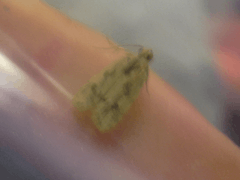Stoeberhinus testaceus
- "Potato moth" redirects here. This can also refer to several other species, see below.
| Potato moth | |
|---|---|
 | |
| Imago captured on Maui (Hawaiian Islands) | |
| Scientific classification | |
| Kingdom: | Animalia |
| Phylum: | Arthropoda |
| Class: | Insecta |
| Order: | Lepidoptera |
| Division: | Ditrysia |
| Superfamily: | Gelechioidea |
| Family: | Autostichidae |
| Subfamily: | Autostichinae |
| Genus: | Stoeberhinus Butler, 1881 |
| Species: | S. testaceus |
| Binomial name | |
| Stoeberhinus testaceus Butler, 1881 | |
| Synonyms | |
|
Numerous, see text | |
Stoeberhinus testaceus (potato moth) is a gelechioid moth, supposedly the only species of its genus Stoeberhinus. However, the genus might also include some related moths presently placed in Autosticha. It belongs to the subfamily Autostichinae, which is either placed in the concealer moth family (Oecophoridae), or in an expanded Autostichidae.[1]
It is a small moth with buff and brown-mottled ("potato"-colored) forewings. Like Autosticha, this moth has the second and third forewing vein emerging from a common stalk; unlike in that genus, the labial palps of S. testaceus males are beset with feathery hairs, while the labial palps of the females are inconspicuous and do not taper like those of both sexes of Autosticha.[2]
This moth is common and widespread in the warmer parts of the Pacific region; was originally described from specimens collected at Honolulu (Oʻahu, Hawaiian Islands). The species has been recorded from Java, the New Hebrides, Fiji and Samoa, the Cook Islands, from the Marquesas across the Society and Tuamotu Islands to the Austral Islands, as well as from the Galápagos Islands (though it might not breed there). Its origin is not well understood and it seems to be something of a "supertramp species".[2]
The caterpillar larvae eat all sorts of dry leaves, in which they build silken tunnels. They have also been recorded on living plants of the looking-glass mangrove (Heritiera littoralis), though the significance of this is unknown.[2]
Nomenclature
The common name of S. testaceus is liable to ambiguity, as several other more or less closely related moths are also associated with potatoes, usually as nuisance pests or worse. These are:
- Gelechiidae: Gelechiinae
- Phthorimaea operculella – potato tuber moth
- Symmetrischema tangolias – Andean/South American potato tuber moth
- Tecia solanivora – Guatemalan potato moth
- Noctuidae: Noctuinae
- Agrotis bilitura – potato cutworm
While all of these may at least of local economic significance, P. operculella and S. tangolias occasionally cause more serious damage to potato crops. S. testaceus, by contrast, is a mostly harmless species named more for its color than for any physical association with potato plants.
Synonyms
This moth has become known under several invalid scientific names. For the genus, these are:[1]
- Staeberhinus (lapsus)
- Staeberrhinus Rye, 1882 (unjustified emendation)
For the species:[2]
- Stoeberhinus testacea (lapsus)
- Stoeberhinus testaceous Swezey, 1910 (unjustified emendation)
Footnotes
References
- Clarke, John Frederick Gates (1986): Pyralidae and Microlepidoptera of the Marquesas Archipelago. Smithsonian Contributions to Zoology 416: 1-485. PDF fulltext (214 MB!)
- Pitkin, Brian & Jenkins, Paul (2004): Butterflies and Moths of the World, Generic Names and their Type-species – Stoeberhinus. Version of 2004-NOV-05. Retrieved 2011-OCT-17.